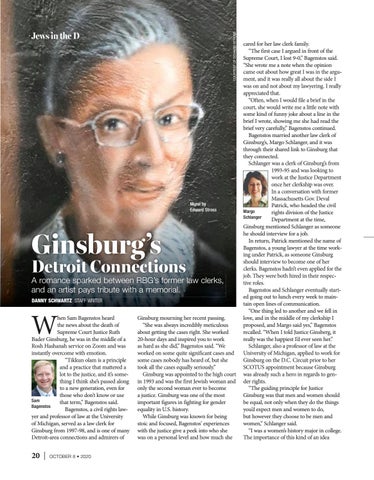COURTESY OF EDWARD STROSS
Jews in the D
Mural by Edward Stross
Ginsburg’s
Detroit Connections A romance sparked between RBG’s former law clerks, and an artist pays tribute with a memorial. DANNY SCHWARTZ STAFF WRITER
W
hen Sam Bagenstos heard the news about the death of Supreme Court Justice Ruth Bader Ginsburg, he was in the middle of a Rosh Hashanah service on Zoom and was instantly overcome with emotion. “Tikkun olam is a principle and a practice that mattered a lot to the justice, and it’s something I think she’s passed along to a new generation, even for those who don’t know or use Sam that term,” Bagenstos said. Bagenstos Bagenstos, a civil rights lawyer and professor of law at the University of Michigan, served as a law clerk for Ginsburg from 1997-98, and is one of many Detroit-area connections and admirers of
20 |
OCTOBER 8 • 2020
Ginsburg mourning her recent passing. “She was always incredibly meticulous about getting the cases right. She worked 20-hour days and inspired you to work as hard as she did,” Bagenstos said. “We worked on some quite significant cases and some cases nobody has heard of, but she took all the cases equally seriously.” Ginsburg was appointed to the high court in 1993 and was the first Jewish woman and only the second woman ever to become a justice. Ginsburg was one of the most important figures in fighting for gender equality in U.S. history. While Ginsburg was known for being stoic and focused, Bagenstos’ experiences with the justice give a peek into who she was on a personal level and how much she
cared for her law clerk family. “The first case I argued in front of the Supreme Court, I lost 9-0,” Bagenstos said. “She wrote me a note when the opinion came out about how great I was in the argument, and it was really all about the side I was on and not about my lawyering. I really appreciated that. “Often, when I would file a brief in the court, she would write me a little note with some kind of funny joke about a line in the brief I wrote, showing me she had read the brief very carefully,” Bagenstos continued. Bagenstos married another law clerk of Ginsburg’s, Margo Schlanger, and it was through their shared link to Ginsburg that they connected. Schlanger was a clerk of Ginsburg’s from 1993-95 and was looking to work at the Justice Department once her clerkship was over. In a conversation with former Massachusetts Gov. Deval Patrick, who headed the civil Margo rights division of the Justice Schlanger Department at the time, Ginsburg mentioned Schlanger as someone he should interview for a job. In return, Patrick mentioned the name of Bagenstos, a young lawyer at the time working under Patrick, as someone Ginsburg should interview to become one of her clerks. Bagenstos hadn’t even applied for the job. They were both hired in their respective roles. Bagenstos and Schlanger eventually started going out to lunch every week to maintain open lines of communication. “One thing led to another and we fell in love, and in the middle of my clerkship I proposed, and Margo said yes,” Bagenstos recalled. “When I told Justice Ginsberg, it really was the happiest I’d ever seen her.” Schlanger, also a professor of law at the University of Michigan, applied to work for Ginsburg on the D.C. Circuit prior to her SCOTUS appointment because Ginsburg was already such a hero in regards to gender rights. “The guiding principle for Justice Ginsburg was that men and women should be equal, not only when they do the things you’d expect men and women to do, but however they choose to be men and women,” Schlanger said. “I was a women’s history major in college. The importance of this kind of an idea







